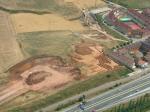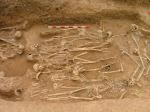Summary (English)
This was a burial site during the French occupation, made out of necessity because of the number of deaths in the capital, both among French troops and the inhabitants of Burgos. Even so, there are no documentary references to the burial places except for indirect quotes and none of them refer to a geographical area. The selected location was a well-ventilated sandy area at a slight distance from the city centre, strategically placed in accordance with hospital network for this time.
The 23 documented mass graves show a large degree of structural and material uniformity. They constitute a group buried at more or less the same time which must be related to an emergency burial place for 1,287 buried subjects. The graves are aligned in parallel and have a rectangular base, basin-shaped section, vertical walls 25 meters long and a varying depth of around 1 meter. The bodies show a neglect of individual positioning, and no evidence of shrouding; up to five burial levels are overlapped with extraordinary disjointing. The absence of clothing and footwear is total; the scarce recovered materials are pins, buttons, etc. Furthermore, 2 bodies in caskets were documented in one grave; another contained maimed bodies and a third grave had skeletal parts of a horse ( Equus caballus ) with anatomical connection.
Anthropological analysis has been limited by the unequal preservation of the remains, but the presence of females is limited (1 certain and 5 probable individuals). The majority of individuals were between 24 and 30 years of age (16.18%) and older than 30 (11.37%), as well as adolescents (2.8%). The identified palaeopathologies point to pre-mortem causes of death typical of a military conflict and executions, but also of partial or total cures of ante-mortem lesions. The heights and ages of death indicate that the recruitment needs surpassed the fixed standards.
The archaeological register and the historical-documental study allow us to assign to Mirabueno a chronology associated with the Peninsular War following General Wellington’s siege of Burgos castle in 1813.
- Carmen Alonso Fernández
Director
- Carmen Alonso Fernández, CRONOS S.C.
Team
Research Body
- CRONOS S.C.
Funding Body
- Empresa privada






![Download [PDF]](/excavation/skins/fasti/images/results/download_sml.png)
